Hey, DC fans, welcome to a new feature here on DC Comics News — Time Bubbles! Each week, we’ll look back at DC titles published at a given point along the great comic book continuum.
Now, in doing this run down, it’s important to realize that New Release Wednesday is a fairly recent phenomenon in the world of comic book publishing. For the first several decades of the industry, particularly when DC Comics were distributed to newsstands by sister-company Independent News, they came out twice each week, and it wasn’t always on Wednesday. So, for Time Bubbles, we will consider “this week” to be whatever week contains a given Wednesday. Thus, for this first column, we’ll be examining the first week of March, 1952 — 65 years ago! Wednesday in that week fell on March 5, so, what we’re looking at here are comics released between Sunday, March 2, and Saturday, March 8.
As it so happens, DC Comics (then officially National Comics Publications), released eight titles during the first week of March 1952 — four on Wednesday, March 5, and four on Friday, March 7.
Unless otherwise noted, all of the comics below had 32 interior pages and sold for 10¢. For what it’s worth, 10¢ in 1952 equates to about 92¢ in 2017 dollars.
And, for the record, DC released 24 comics for all of March 1952, and only six of them featured super-heroes! But, without a doubt, the big whoop of the week was Superman #76, featuring the real and for-true, one-and-only first actual meeting of Superman and Batman, in which they each learned the other’s secret identity. This was it fanboys — adventures of the Justice Society of America in All-Star Comics excepted, this is the real start of the shared DC Universe!
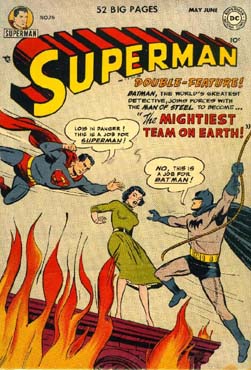 SUPERMAN #76
SUPERMAN #76
(on-sale March 7)
48 pages, with three Superman stories — When I was a kid in the 1970s and 1980s, the Holy Trinity of DC Comics was really just Batman, with Superman as an also-ran, and Wonder Woman included by TPTB, when she was thought of at all, as a pity date. But there’s no question that, in this era, Superman was DC’s bread and butter. For proof, look no further than the fact that, setting aside the exception that was World’s Finest Comics, most DC titles in 1952 were 32 pages, with a few dressing out at 40. But Superman ran to a whopping 48 pages, its higher sales creating economies of scale even as economic reality was forcing DC to scale back as far is it could elsewhere. It would not be until 1962, another decade yet, when DC would finally bite the bullet, having pared back its books as far as they could be and still maintain structural integrity, and raise the cover price two whole pennies. Oh, by the way, the “52 Big Pages” exclamation on the cover of this issue is kind of a cheat. It includes the covers.
So, what do we have here? Well, not to put too fine a point on it, but this was the original fanboy wet dream. I mean, imagine you’re a 12 year old kid in 1952 — because it’s 1952 and 12 year old kids still read comics books. Apart from the covers to WFC and New York World’s Fair Comics, Superman and Batman had appeared together in a story only three times before this, and one was a humor strip in All-Funny Comics #16 (on-sale around Jan. 1, 1947), in which comics characters come to life, so that one really doesn’t count. In the other two, the world’s finest team appeared as Justice Society reserve members, in All-Star #7 (Aug. 25, 1941), and #36 (June 25, 1947).
[Aside: The All-Funny story was done by Thurston Harper, but the Grand Comics Database says the DC heroes in that story (Green Arrow and Vigilante also appeared) look to have been lifted from stats of previously published appearances.]
Batman also appeared on The Adventures of Superman radio show, with his debut there on March 2, 1945. Batman and Robin would appear several times on the program, sometimes in place of Superman even, which was a ploy designed to give Superman voice actor Bud Collyer vacation time, given that there was no such thing as reruns in live radio.
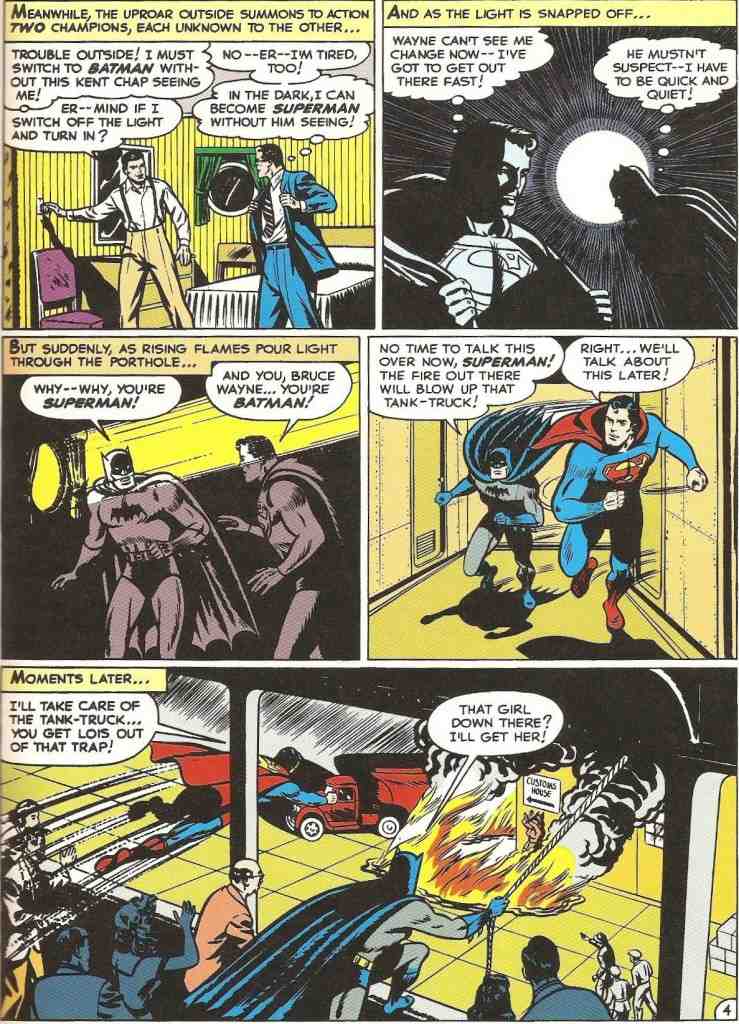 You have to wonder why it took DC itself so long to trip over the seemingly obvious idea of pairing its two biggest properties. But it was a different world back then, and while today DC has no qualms at all about dropping Batman into every third book, with about 12 monthly titles of his own, in this era the company worried about diluting its brand by over-saturating the market with either top character. In fact, as big a sales bonanza as this issue must have been — DC wasn’t made to publish circulation data until 1960, at which point Superman was moving 810,000 copies per month, behind only Uncle Scrooge and Walt Disney’s Comics and Stories — DC did not team Superman and Batman again until two years later, in WFC #71 (May 26, 1954). And that only happened because of a drop in package size from 64 pages at 15¢ to 32 for 10¢, which necessitated pairing the two heroes in one story to save cutting either Green Arrow or Tomahawk from the line-up.
You have to wonder why it took DC itself so long to trip over the seemingly obvious idea of pairing its two biggest properties. But it was a different world back then, and while today DC has no qualms at all about dropping Batman into every third book, with about 12 monthly titles of his own, in this era the company worried about diluting its brand by over-saturating the market with either top character. In fact, as big a sales bonanza as this issue must have been — DC wasn’t made to publish circulation data until 1960, at which point Superman was moving 810,000 copies per month, behind only Uncle Scrooge and Walt Disney’s Comics and Stories — DC did not team Superman and Batman again until two years later, in WFC #71 (May 26, 1954). And that only happened because of a drop in package size from 64 pages at 15¢ to 32 for 10¢, which necessitated pairing the two heroes in one story to save cutting either Green Arrow or Tomahawk from the line-up.
This first real, on-purpose team-up of Superman and Batman, entitled, “The Mightiest Team in the World!” has been reprinted by DC eight times, most recently in Batman/Superman: The Silver Age Omnibus. If that book’s $75 price tag is a wallet-buster for you, however, you can read the story on The World’s Finest Blog, which is a neat little site that gives a run-down of every issue of WFC.
The art here is by Curt Swan, marking an early Superman outing for the Silver Age stalwart and a rare swing (but for the occasional Hostess Fruit Pie ad) on Batman. Speaking of swing, on the splash page, just what do you suppose the other end of Batman’s bat-line is attached to? A passing jet, maybe?
The story by Edmond Hamilton has an unusual pretense for bringing Superman and Batman together. With Batman and Robin having captured every crook in Gotham (like that would ever happen!), Bruce Wayne decides to treat himself to a vacation (like THAT would ever happen!!) and books passage on a cruise ship, while Robin, hitherto an orphan, decides to go visit “relatives living upstate.” Clark Kent also happens to be taking a vacation on the same cruise ship (recall, Supes didn’t have a luxurious Fortress of Solitude to relax in at this point), and the two heroes end up sharing a cabin when the purser decides the ship is overbooked and he’ll have to bunk them up. So, the multi-billionnaire (albeit a mere multi-millionaire in these pre-inflationary days) is all, like, “Yeah, no bigs, I’ll just share this closet with some rando threadbare newspaper reporter. Dibs on the top bunk!”
Meanwhile, on the docks, Lois, who’s come to see Clark off, spots a man firing incendiary bullets at a tank truck — because Lois is the kind of crack reporter who can tell an incendiary bullet from about 500 yards away as it speeds through the air toward its target. As it turns out, there’s a diamond hidden in the tanker (hey, you, don’t bother asking why) and the crook, taking some fashion advice from Heat Wave, wades past the resulting flames from the exploded truck to snatch it. Meanwhile, poor Lois, eagle-eye that she is, decides she needs to get a closer look and, because she’s Lois, gets trapped by the fire.
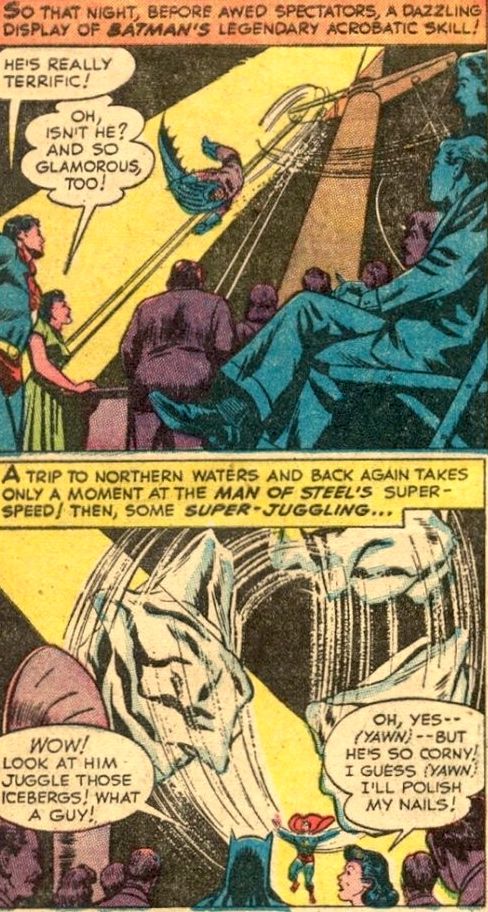 Clark Kent and Bruce Wayne are in their cabin when they hear the commotion outside, but are unable to strip down to the long underwear with the other present. So, Bruce asks if he can switch off the light for bed (this cruise ship is leaving port in the middle of the night, as all cruise ships do) and thus, drenched in darkness, the two heroes being their specially patented switcheroo. Yes, apparently it was THAT dark. But, alas, light from the fire outside flickers in through the cabin’s porthole window, providing just enough light for our heroes to discover the other half-changed.
Clark Kent and Bruce Wayne are in their cabin when they hear the commotion outside, but are unable to strip down to the long underwear with the other present. So, Bruce asks if he can switch off the light for bed (this cruise ship is leaving port in the middle of the night, as all cruise ships do) and thus, drenched in darkness, the two heroes being their specially patented switcheroo. Yes, apparently it was THAT dark. But, alas, light from the fire outside flickers in through the cabin’s porthole window, providing just enough light for our heroes to discover the other half-changed.
And so . . . THEY KISS! No, I’m kidding. But I’m sure that story exists on the internet somewhere, if that’s your thing (not that there’s anything wrong with that).
Now, you may ask, why didn’t Superman just change and fly away at the speed of light? Remember, this is the Atom Age, and Superman is not quite up to moving-planets-with-his-pinky power levels just yet.
So, Superman and Batman quickly decide they’ll worry about their exposed identities later, and rush off to save Lois. That done, a cop tells our heroes the bad guy got away, but nobody left the docks. Ah-HA! he must be on the ship! Batman declares, taxing his detective skills to their limit. Well, there’s only one thing to do — Superman and Batman will have to go on the cruise in order to flush out the bandit. Superman doesn’t just search the ship with his x-ray vision, because, oh, I dunno, the entire thing is made of lead, I guess.
But then (Oh, no!) Lois shows up, having booked a room in place of some Sally who got too frightened by the exploding tanker to set sail. She’s decided to take her vacation alongside Clark and scoop him on the diamond bandit story, and, so, “had a suitcase rushed down” to the ship.
“Gosh — why did she have to come along?” laments Superman.
“Why not? She seems like a charming girl!” says horndog Tony Stark . . . er, I mean Batman.
Well, you can guess the rest. Superman and Batman take turns helping each other protect their secret identities from nosey-Parker Lois and entertain the ships passengers (Superman juggles iceburgs! Batman does . . . ah, somersaults!! Yeah, that’s the ticket. Impressive.)
Oh, and they also catch the crook. Turns out, Superman couldn’t find the diamonds because they were hidden inside the lead bullets of Mr. Bad Man’s gun. Of course, I needn’t remind you yet again that this was a different age, and someone boarding a cruise ship with a gun was not necessarily Clue One.
Finally, Superman and Batman resolve to keep secret each other’s identities while competing fair and square for the hand of fair Lois. Oh, but too late — as they leave the ship, Robin is there to meet his mentor and has already convinced Lois to go out to dinner with him. Using his Bat-allowance, I’d imagine.
“Isn’t he the cutest little chap?” Cougar Lois says, as she struts off arm-in-arm with the Boy Wonder.

Well, that’s it. Of course, that was just the start. These days, Superman and Batman have been playing super-hero team-up for so long, even their sons are in on the act. But that’s another story.
If reprints and online posts aren’t your bag and you’d rather have the real thing, expect to shell out at least $280 for a low-grade Good condition copy of this issue, at least according to online price guide ComicBookRealm.com. A Near Mint version will break the bank at $4,000, while even a mid-grade Fine runs to $1,200!!
Also out this week in 1952:
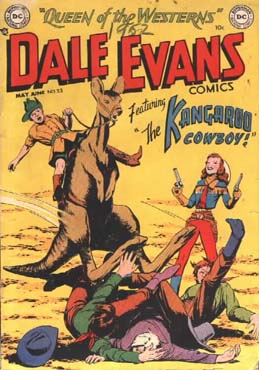 DALE EVANS COMICS #23
DALE EVANS COMICS #23
(on-sale March 5)
Three Dale stories, plus one featuring Sierra Smith, Western Detective — Launched in July 1948, this title lasted just one more issue after this, facing cancellation with #24 (on-sale May 23). All but one of the first 15 issues sported photo covers of Dale, who was the only-slightly-less-famous-in-her-day wife of cowboy crooner Roy Rogers.
At 36, Dale Evans was a little long in the tooth by modern celebrity standards when she got her own comic book. Roy, by contrast, had been galloping across the panels of Dell comics since 1944. How Dale ended up at DC is probably an interesting story, but I don’t know it. But due to the Dell deal, Roy could not appear in these comics, and was only ever mentioned in the “Roundup” feature, which was purportedly written by Dale herself. It wasn’t.
The stories, mostly by Ryerson Johnson, bounced Dale back and forth between the Old West and modern Hollywood, while artists Jim McArdle, Susie Day, and Ray Burnley (brother of Starman creator Jack Burnley), made little effort to make the character appearing in the comic look anything like Dale herself. And, in what must have been the biggest affront to young fans, Dale rode horses named Pal and Soda, instead of her beloved Buttercup!
GCD does not identify the writer of the three Dale stories in this issue (“The Kangaroo Cowboy!”, “The Salted Gold Mine!” and “The King of the Grizzlies!”) or of the Sierra Smith tale (“The Case of the Jovial Jackdaw!”), but it does list McArdle as artists for Dale, and Allen Ulmer on Sierra.
After cancellation of her DC title, Dale would join Roy in the Dell stable for Queen of the West Dale Evans, first as two one shots in the “Four Color” series, then in her own title from 1954 until #22, out on Dec. 2, 1958.
Dale died in 2001 at age 88. The dirty little secret? Roy was actually her fourth husband.
This issue, if you can find it, will set you back anywhere from $11 (in Good condition) to $160 (Near Mint), with a Fine mid-grade average of $48.
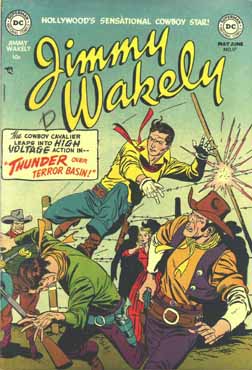 JIMMY WAKELY #17
JIMMY WAKELY #17
(on-sale March 5)
Three Jimmy stories plus one generic western and one featuring Kit Colby, Girl Sheriff — Like Dale, poor Jimmy had just one more bullet left in the chamber after this month. Launched in July 1949, this title ended with #18, out on May 9. Photo covers graced the first seven issues.
Jimmy Wakely, if you don’t know, was one of the last singing cowboys. Yeah, that was a fad for quite a while there. He actually scored two No. 1 country singles in 1948. He was in a gross ton of movies, too.
All three Jimmy stories in this issue (“Terror at Thunder Basin!”, “The Sign of the Black ‘A’!” and “Jimmy Wakely — Dude Cowboy!”), as well as the cover, were drawn by the great Gil Kane, who was all of 26 at the time. Kane handled the art on the last four issues of this title, while the first 14 were done by the equally awesome Alex Toth. Kane & Toth? Hey, I dunno about you, fanboy, but if DC could work a deal with the Wakely Estate, I’d pony up for a Jimmy Wakely Showcase volume in a hurry!
The Kit Colby story in this issue (“Lawbreakers of Arrow Bend!”) was drawn by Irwin Hansen, who you probably know better as the creator of Wildcat. There’s also a couple of short features by Mort Drucker, of MAD magazine fame.
Jimmy fares about as well as Dale on the back issue market. Look for this issue to cost you anywhere from $11.50 (Good), to $49.50 (Fine), on up to $165 (Near Mint)
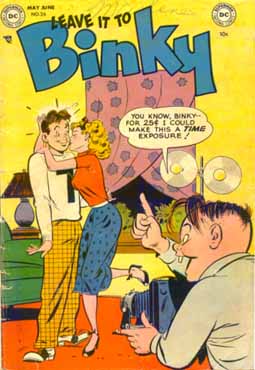 LEAVE IT TO BINKY #26
LEAVE IT TO BINKY #26
(on-sale March 5)
40 pages, with three Binky tales, plus one, each, featuring Little Allergy and Pam — Binky had a nice long run. An obvious Archie rip-off, he began his career chasing skirts in December 1947, persisting on a bi-monthly schedule until January 1954, when he got a promotion to eight issues per year though 1955. Back to bi-monthly status at the start of 1956, Binky bit it with #60, (on-sale July 3, 1958) just as the Silver Age was really gearing up. Perhaps not coincidentally, Binky got a reprieve toward the close of the Silver Age, with #61 hitting stands on April 11, 1968. Again on a bi-monthly schedule, Binky’s title got truncated to something more titular, with the loss of “Leave it to” at #72. Then the ax fell for good with #81, out on August 10, 1971.
But that also was not the end of the tale, as Binky, for no apparent reason I can discern, got one final issue, #82, which hit on August 2, 1977. My theory is this one-shot encore of the original number proves that Binky was, in actuality, DC’s first Black Lantern.
For the DC trivia buffs out there, Bertram “Binky” Biggs has the distinction of being the very first DC character to make his debut in his own title. Yeah, even Superman and Batman had to prove themselves elsewhere first! Leave it to Binky also pre-dated Leave it to Beaver by almost a full decade, if you were wondering, although he did trail P.G. Wodehouse’s Leave it to Psmith by a good 20 years. And I’m still waiting for the latest issue of Leave it to Chance, if anyone cares.
All of the Binky stories in this issue were drawn by Bob Oksner, who was kind of a one-man band for DC in the humor department, although his super-hero output is impressive, as well.
The market range on this issue runs from $6.50 (Good), to $28.50 (Fine), and $95 (Near Mint).
 MOVIETOWN’S ANIMAL ANTICS #38
MOVIETOWN’S ANIMAL ANTICS #38
(on-sale March 5)
Two stories starring the Raccoon Kids, plus one, each, for Dizzy Dog, and Custer Cat & Cheesy Mouse — This title came along on Jan. 4, 1946, just as DC was making its first flailing stab at finding a genre to replace dwindling interest in super-heroes. It ran on a bi-monthly schedule for its entire run. However, initially it was simply titled Animal Antics. The “Movietown” tag got added with #24 (on-sale Nov. 4, 1949), as DC tried to goose reader interest in its funny animal line by faking a tie to TV and film properties. The Raccoon Kids lead feature — think Chip ‘n’ Dale in domino masks — took over the title with #52 (on stands July 2, 1954), which was the status quo until cancellation came at #62, on August 9, 1956. The Kids then got two final issues, #63 and #64, a year later, in June and August 1957.
Both Raccoon Kids stories are by Otto Feuer, who handled a lot of DC’s funny animal output of the period, including Peter Porkchops and Dodo & The Frog. About three years after this issue, Feuer would found his own animation studio, Animotion Associates. He’d later end up working for Filmation for most of the 1970s and 1980s. The Dizzy Dog feature is by Sheldon Mayer, of Scribbly and Sugar & Spike fame — and also the guy who convinced Max Gaines to take an unsold strip called Superman over to Harry Donenfeld — while Custer & Cheesey is by Rube Grossman. This issue also has a passel of short features by Martin Naydel, who is not to be confused with original Green Lantern creator Martin Nodell.
One of the least expensive back issues on this week’s list, you can land this one for a mere $6.25 in Good, and $27 in Fine, but expect to shall out $90 for a Near Mint copy (if you can even find one, that is).
 BUZZY #43
BUZZY #43
(on-sale March 7)
40 pages, with four Buzzy stories, plus one featuring Liz — Binky may have been discount Archie, but Buzzy was DC’s first actual imitator, right down to his red hair, which suddenly turned blond at #20. The title lasted from Oct. 18, 1944 until #77, out on July 17, 1958.
In truth, however, Buzzy Brown was not much of an Archie clone. He began life in All-Funny Comics as a horn blowing hep cat sandwiched somewhere between jazz and beatnik culture, and most early stories were about his band and musical efforts. That aspect was toned down as time went on, however, and Buzzy soon became more like the typical girl-chasing teenage Lothario.
Although it’s not know for certain, it’s believed Buzzy was created by Alvin Schwartz, one of the most prolific comic book writers of all time, who worked extensively on both Superman and the original Captain Marvel. Schwartz is noted as the creator of Bizarro, and, just to tie in the Superman/Batman theme that started off this column, he wrote the story in World’s Finest Comics #71 that began their long-running co-feature.
However, the GCD entry for this issues is all question marks, but for the short features by Naydell and Henry Boltinoff. So, you’re guess is as good as mine as to who did the work here. If you want to scrounge up a copy to try and work it out for yourself, look to pay anywhere from $5.50 (Good), to $24 (Fine), to $80 (Near Mint).
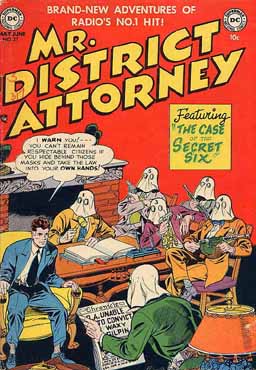 MISTER DISTRICT ATTORNEY #27
MISTER DISTRICT ATTORNEY #27
(on-sale March 7)
40 pages, with three Mr. D.A. stories, plus one generic crime yarn — Based on a radio drama, this title ran from Nov. 14, 1947 to #67, which hit stands on Nov. 4, 1958.
Of the many genres publishers tried out after the first wave of super-heroes faded from the scene, one of the most popular was crime comics. DC wanted a seat on that bandwagon, but it didn’t care to suffer guilt by association, given the excesses of day that would eventually culminate in publication of Seduction of the Innocent and the infamous Kefauver hearings in the U.S. Senate that nearly obliterated the entire comic book industry. DC was pretty prescient in that respect, promoting early on its mostly made-up editorial advisory board that purportedly reviewed all its comics and guaranteed clean, wholesome fun.
So, in order to cash in on crime but still remain respectable, DC got into the game by licensing a trio of radio dramas, Gang Busters, Big Town, and Mr. District Attorney.
If “Mr. District Attorney” seems like kind of a goofy title, DC didn’t have a choice — and not just because that was the title of the radio show. It seems the D.A. in question didn’t have an actual name until the program (which launched on NBC radio on April 3, 1939) made the leap to television (landing at ABC on Oct. 1, 1951). on TV, the D.A. was dubbed Paul Garrett (no relation to Blue Beetle Dan Garrett, so far as I know — although the show is probably in the public domain by now, so if DC chooses to bring back the original Beetle, who was a police officer, it could easily lump along his older D.A. brother)
Anyway, the radio show enjoyed its last broadcast on June 13, 1952, while the short-lived TV show got the ax on June 23 — both just three months after this issue hit stands! Yeah, not only was it “Brand New Adventures of Radio’s No. 1 Hit,” soon enough, it was the ONLY adventures. Still, this title did outlast its source material by six years.
The three Mr. D.A. stories in this issue (“The Case of the Secret Six,” “The Driving School for Death,” and “The Crimes of Caesar Torrow”) are all by an uncredited writer, while drawn by Howard Purcell. He created Sargon the Sorcerer and did a lot of Golden Age work on Green Lantern, including the first issue cover of Alan Scott’s own title.
Mr. D.A. back issues don’t come cheap. For this one, look to pay between $9.75 (Good), $42 (Fine), and $140 (Near Mint).
 SENSATION COMICS #109
SENSATION COMICS #109
(on-sale March 7)
Three generic mystery tales plus one starring Johnny Peril — Famously founded on Nov. 7, 1941, as a home to Wonder Woman, this title took the Amazon Princess in more of a romance direction toward the end of its run, about the same time it dropped to a bi-monthly schedule. However, at #107 (on-sale Nov. 9, 1951) the fix was in and super-heroes got the boot en toto in favor of a mystery format. This month features the final use of the original title. With #110 (out on May 9, 1952) the book became Sensation Mystery. That change apparently did little to boost circulation, however, and the run came to an end at #116, on May 20, 1053.
A one-shot #1 of Sensation Comics came out in 1999 as part of the “Justice Society Returns” skip-week event. The title then returned in October 2014 as a digital-first series dubbed Sensation Comics: Featuring Wonder Woman. That run lasted 17 issues, until Feb. 2016.
The Murphy Anderson drawn cover to the issue was creep-o-riffic enough that it was swiped a decade later for Justice League of America #10 (on-sale Jan. 30, 1962), although that could be because both were written by Gardner Fox. The story in this issue (“The Fingers of Fear!”) was drawn by Carmine Infantino. If you want to read it, seek out The Witching Hour #17 (Aug. 10, 1971), or Showcase Presents: The Witching Hour, Vol. 1 (from 2011).
The short two-page story by John Giunta in this issue (“The Ferry Was Waiting!”) was reprinted in The Unexpected #127 (July 22, 1971). Sadly the Gil Kane-drawn story, “The Beast that Walked Like A Man!”, has never been reprinted.
Finally, the Johnny Peril story in this issue (“The Demon in the Mirror!”) is by Robert Kanigher and Toth. It can be found in The Witching Hour #38 (Oct. 16, 1973). Johnny was a straight-up adventure strip, which morphed into more of a mystery theme toward the end. A perennial back-up feature from his debut in the “Just a Story” feature in Comic Cavalcade #19 (Dec. 13, 1946), Johnny had rough luck at first, getting the boot when CC switched format from super-hero to funny animal. The same thing happened when his next home, All-Star Comics, dumped the JSA in favor or westerns. He then took over Danger Trail just in time for its last issue. Finally, it was Johnny who was the beneficiary of a format change, with Wonder Woman’s exile from Sensation. He even survived the title change, becoming the lead feature, although that headline status was short lived. Johnny went into limbo until a second, equally short-lived revival in The Unexpected, from #106 (Feb. 6, 1958) to #114 (June 5, 1969)
Those latter-day adventures, or reprints of his Atom Age stories, may be the best bet for the cost conscious. The second priciest comic out this week on today’s market, Sensation #109 will set you back $1,400 in Near Mint, although you might be able to find one in Fine condition for around $420, or in Good for $98.
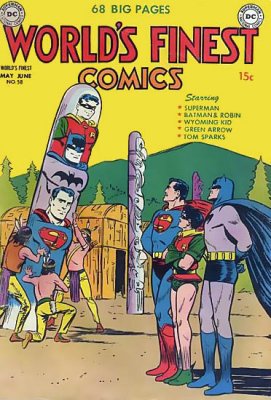 The full rundown for the rest of March 1952 included the following (and note that, for whatever reason, DC issued no comics during the second week of March this year):
The full rundown for the rest of March 1952 included the following (and note that, for whatever reason, DC issued no comics during the second week of March this year):
Wednesday, March 19
REX, THE WONDER DOG #3 (two Rex stories)
HERE’S HOWIE COMICS #3 (two Howie stories, plus one, each, featuring Coby, Melvin, and Liz)
STAR SPANGLED COMICS #128 (featuring Doctor 13, Captain Compass, Robin, and Tomahawk)
Friday, March 21
ADVENTURE COMICS #176 (40 pgs featuring Superboy, Aquaman, Johnny Quick, and Green Arrow)
FUNNY STUFF #66 (featuring Dodo and the Frog, Biggety Bear, and Nip & Chip)
GIRLS’ LOVE STORIES #17 (40 pgs with four stories)
TOMAHAWK #11 (40 pgs, with three Tomahawk stories, a generic western, and one featuring Tales of the Arrow Maker)
WONDER WOMAN #53 (4o pgs with four Wonder Woman stories)
Wednesday, March 26
ACTION COMICS #168 (40 pgs featuring Superman, Tommy Tomorrow, Congo Bill, and Vigilante)
BIG TOWN #15 (three Big Town stories, plus one of Johnny Law)
HOLLYWOOD FUNNY FOLKS #46 (two Nutsy Squirrel stories, plus one, each for Nip & Chip, and Doodles Duck)
WESTERN COMICS #33 (featuring Wyoming Kid, Rodeo Rick, Nighthawk, and Cowboy Marshal)
Friday, March 28
DETECTIVE COMICS #183 (40 pgs featuring Batman, Roy Raymond, Robotman, and Pow-Wow Smith)
REAL SCREEN COMICS #50 (40 pgs featuring two Fox and the Crow stories, with one, each, for Tito and his Burrito, and Flippity & Flop)
STRANGE ADVENTURES #20 (three sci-fi stories, plus one starring Captain Comet)
WORLD’S FINEST COMICS #58 (64 pgs for 15¢, featuring Superman, Green Arrow, Wyoming Kid, Tom Sparks Boy Inventor, and Batman)
The breakdown by genre for March 1952 came to:
• Super-hero — 6 titles
• Funny animal — 4
• Teen humor — 3
• Western — 3 (two of IRL personalities)
• Crime — 2 (both radio drama adaptations)
• Animal adventure — 1
• Anthology — 1 (mystery cover feature)
• Frontier — 1
• Mystery — 1
• Romance — 1
• Science fiction — 1
Well, that’s the Bubble for this first time trip.
NEXT WEEK: We stop in at the second week of March 1977 (40 years ago!) to witness the dizzying debut of Shade, the Changing Man!
Until then, remember: “Hey, Kids!! COMICS!”
